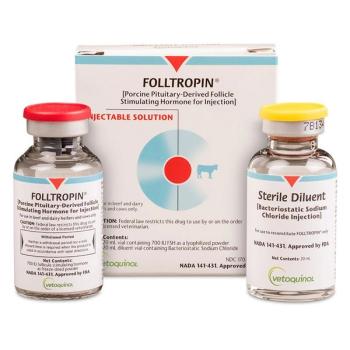Structural epilepsy is diagnosed when there is known structural abnormality of the forebrain. Possible causes of structural disease include vascular, inflammatory/infectious, degenerative diseases, trauma, neoplasia, or congenital malformations. Although a structural lesion may result in interictal abnormalities, it is not uncommon to have a “silent lesion” that creates a seizure focus but no identifiable neurological abnormalities. Therefore, a normal neurological examination does not preclude a diagnosis of a structural cause of seizures.
Reactive seizures occur when a structurally normal brain reacts to an abnormality circulating in the blood, such as toxins, medications, or metabolic disorders.
In this patient, blood work was unremarkable and there was no indication of repeated toxin exposure, so reactive seizures are unlikely. Based upon signalment, history, and exam findings, it is a bit difficult to differentiate idiopathic from structural epilepsy in this case. Age of onset is outside of the 6 months to 6 years of age for onset of idiopathic epilepsy, but we cannot say with certainty that there weren’t unwitnessed previous seizures.
Plan
What recommendations should veterinarians make to a pet owner that presents for seizures?
Baseline diagnostics
I always recommend a CBC and complete chemistry analysis (including electrolytes and CK) in all seizure cases. If there is a suspicion of an underlying metabolic condition (e.g., hepatic encephalopathy, etc.) based upon these initial lab results, the history or signalment, further metabolic testing such as pre- and post-prandial bile acids, thyroid level testing, etc. may be recommended.
Advanced diagnostics
The next diagnostic consideration is whether to perform advanced imaging and cerebrospinal fluid analysis. It is never wrong to offer an MRI and CSF analysis, even in a young adult dog with no interictal abnormalities, if the owner is willing to pursue these tests. In cases highly suspected to be idiopathic epilepsy, based upon clinical presentation and signalment, I try to help the pet owners make an informed decision by discussing that the likelihood of finding an abnormality is low, but we cannot be certain without imaging. As mentioned earlier, there can be a structural lesion present in the forebrain that is “silent” and may not cause any neurological deficits or interictal abnormalities. In cases that present older than six years of age (sometimes a little younger in brachycephalic breeds), have interictal abnormalities or neurological deficits, or are a breed that commonly develops autoimmune meningoencephalitis (young adult small breed dogs), I strongly recommend advanced imaging and CSF analysis.
Advanced testing in these cases may allow us to treat a specific underlying disease process such as neoplasia or encephalitis or may put everyone’s mind at ease that there is not a progressive structural cause, and we can focus on treating the seizures. We are all cognizant of the fact that some pet owners may not be willing to pursue advanced imaging, but it is still important to discuss this option and allow them to make an informed decision.
Additional reading
1. 2015 ACVIM Small Animal Consensus Statement on Seizure Management in Dogs; J Vet Intern Med. 2016 Mar-Apr; 30(2):477-90
2. Antiepileptic Drug Use Patterns in Suspect Epileptic Dogs Among Neurology and Emergency Specialists; J Am Anim Hosp Assoc 2019; 55:138–143.
3. Placebo Effect in Canine Epilepsy Trials; J Vet Intern Med. 2010; 24:166–170
Treatment
The goal of treating seizures is 100% elimination. However, a more realistic expectation may be to reduce seizure frequency, intensity, and duration. Deciding when to start antiepileptic drugs (AED) therapy should take a number of factors into account and be based on the pet owner’s concerns about seizures or AEDs, side effects of AEDs, risks of seizures, and quality of life for both the pet and owner. It is generally recommended to start AEDs if a pet has 3 or more seizures in 3 months, an episode of status epilepticus or cluster seizures, or a known structural cause of seizures.
Choosing which drug to start with is open to debate. They all have their pros and cons. AED selection should be based upon a working knowledge of the drugs’ side effects and efficacy, owner’s concerns with side effects compared to concern with seizure activity, schedule of administration and its feasibility in the pet-owner’s daily life, and cost of the drug and follow up monitoring. Many clinicians will start with Levetiracetam due to its safety profile. There are uncontrolled studies suggesting its efficacy. However, there is very little data in the literature with placebo-controlled studies to support its use as monotherapy. In a published questionnaire study, the majority of neurologists and critical care specialists use phenobarbital or bromide as their first choice for treatment of seizures.
When deciding which AED to start with it is important to discuss a drug’s pros and cons with the pet owner to help them make an informed decision. Approach it in a fluid manner and adjust, as needed, depending on the patient’s response and tolerance of the AED.
Case outcome
Taking the age of onset of seizures in this patient into consideration, an MRI of the brain was recommended. Imaging was normal and no structural cause of seizures was noted. Cerebrospinal fluid was collected for analysis and was also normal. Based upon normal imaging and diagnostics, this patient was diagnosed with idiopathic epilepsy. Phenobarbital therapy was started due to the frequency of seizures. Six months after initiation of phenobarbital this patient had a total of three seizures and was tolerating the medication well.
There is no single approach to managing seizures in dogs. Every patient and owner have individual and nuanced factors to consider in the case’s management. It is important to take all of this into account when seeing a patient for seizures. We must take a thoughtful approach with open dialogue of expectations and plans for adjustments with the pet owner.
Peter Brofman, DVM, MS, ACVIM (Neurology & Internal Medicine) is the Medical Director and Veterinary Neurologist at Thrive Pet Healthcare Specialists in Albuquerque, New Mexico. He earned a Bachelor of Science degree from Tufts University followed by a Doctor of Veterinary Medicine at Cornell University. He completed a residency in internal medicine at The Animal Medical Center in 2001 then pursued his true calling in neurology, completing his neurology residency at The Ohio State University College of Veterinary Medicine in 2004. Brofman is a founding member of the Veterinary Neurosurgical Society and is currently the National Director of Neurology for Thrive Pet Healthcare. He is board-certified by the American College of Veterinary Internal Medicine in both neurology and internal medicine specialties. He has extensive experience in all aspects of both surgical and medical neurology with a particular interest in spinal trauma and surgery. Brofman’s practice philosophy focuses on the quality of life for both his patients and their family.








